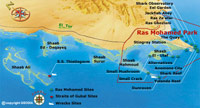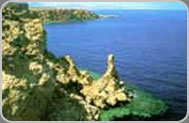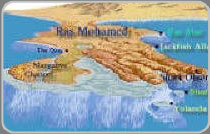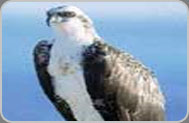|

 Ras Mohamed National Park Ras Mohamed National Park
 Declared in 1983 and subjected to a comprehensive development program initiated in 1989, the Ras Mohammed National Park has since become an essential feature to the economic development on South Sinai. Declared in 1983 and subjected to a comprehensive development program initiated in 1989, the Ras Mohammed National Park has since become an essential feature to the economic development on South Sinai.
The boundaries of the National Park extend from a point opposite the Qad Ibn Haddan lighthouse on the Gulf of Suez to the southern boundary of the Nabq Protectorate on the Gulf of Suez. The area includes the island of Tiran and all shorelines fronting the Sharm el Sheikh tourism development area.
 Tourism in Southern Sinai is inherently linked to the natural resources of the area. Degradation of these natural resources as a result of tourism or development activities is not in the best interests of the investors or the tourists. The Protectorates program seeks to establish an equilibrium between development activities, tourism and the natural resource conservation measures needed to achieve sustainable economic development. Tourism in Southern Sinai is inherently linked to the natural resources of the area. Degradation of these natural resources as a result of tourism or development activities is not in the best interests of the investors or the tourists. The Protectorates program seeks to establish an equilibrium between development activities, tourism and the natural resource conservation measures needed to achieve sustainable economic development.
It is essential that all users recognize their individual responsibility to protect the natural resources of the area, remembering that these are common property resources, of international importance, and the heritage of future Egyptian generations.
 Coral reef ecosystems found in the National Park are recognized internationally as among the world's best. This recognition is based primarily on the diversity of flora and fauna, clear, warm water devoid of pollutants, their proximity to shorelines and their spectacular vertical profile. The reef exists as an explosion of color and life in stark contrast to the seemingly barren desert adjacent to it. In reality, the desert is rich in fauna, mainly nocturnal. These ecosystems are intrinsically linked and thus must be managed as a single unit. Coral reef ecosystems found in the National Park are recognized internationally as among the world's best. This recognition is based primarily on the diversity of flora and fauna, clear, warm water devoid of pollutants, their proximity to shorelines and their spectacular vertical profile. The reef exists as an explosion of color and life in stark contrast to the seemingly barren desert adjacent to it. In reality, the desert is rich in fauna, mainly nocturnal. These ecosystems are intrinsically linked and thus must be managed as a single unit.
The National Park at Ras Mohammed is the first and only Egyptian National Park. Declared in 1983 with an area of 97 kilometers squared, it has since grown to an area of 480 kilometers squared and includes marine and terrestrial areas at the Ras Mohammed Peninsula and the island of Tiran, and all shorelines to the highest annual tide between the main Sharm el Sheikh harbor and the southern boundary of the Nabq Managed Resource Protected Area.
 The Park is notable for its sharply defined raised fossil coral platforms which represent ancient shorelines. These reefs range in age from 15,000 to 2,000,000 years BP (before present). The more recent fossil reefs show similar species composition and structure to present day coral reefs. Recognizable species include: Goniastrea sp., Galazea sp., Porites sp., and others. Fossil reefs, like modern reefs, were also habitats for a profusion of life seen as fossil remains in the Park. Studies of fossil coral reefs provide scientists with valuable insights regarding past climatic conditions, changing sea levels and the effect of these on coral reef ecosystems. The Park is notable for its sharply defined raised fossil coral platforms which represent ancient shorelines. These reefs range in age from 15,000 to 2,000,000 years BP (before present). The more recent fossil reefs show similar species composition and structure to present day coral reefs. Recognizable species include: Goniastrea sp., Galazea sp., Porites sp., and others. Fossil reefs, like modern reefs, were also habitats for a profusion of life seen as fossil remains in the Park. Studies of fossil coral reefs provide scientists with valuable insights regarding past climatic conditions, changing sea levels and the effect of these on coral reef ecosystems.
Coral reefs in the National Park present the visitor with a breathtaking experience. The profusion of life can at times overpower the senses of the first time visitor, but on the reef there is order. Close and careful observation will enable even the uninitiated to identify the more obvious relationships.
 All organisms on the reef have particular adaptations related to their feeding behavior. Damselfish tend their patches of seaweed, defending these with vigor. Parrotfish grind at the base of corals to feed on algae. They then excrete clouds of undigested carbonate which settles and helps to cement the reef. Cleaner wrasse are seen at work on larger fish such as groupers, rays, barracuda removing parasites from their mouths, gills and outer body. Sharks, barracuda, jacks, etc. come to the reef to feed on schools of reef fish. The reef is a complex, often bewildering, ecosystem that once understood will provide endless hours of enjoyment. Careless use will destroy both the structure and ecological equilibrium of the reef. Careful use will ensure the survival of this ecosystem. All organisms on the reef have particular adaptations related to their feeding behavior. Damselfish tend their patches of seaweed, defending these with vigor. Parrotfish grind at the base of corals to feed on algae. They then excrete clouds of undigested carbonate which settles and helps to cement the reef. Cleaner wrasse are seen at work on larger fish such as groupers, rays, barracuda removing parasites from their mouths, gills and outer body. Sharks, barracuda, jacks, etc. come to the reef to feed on schools of reef fish. The reef is a complex, often bewildering, ecosystem that once understood will provide endless hours of enjoyment. Careless use will destroy both the structure and ecological equilibrium of the reef. Careful use will ensure the survival of this ecosystem.
Terrestrial areas in the National Park are a stark contrast to the exuberance of color and life seen on the coral reef. Seemingly devoid of visible life, they are in fact home to the desert fox, Nubian Ibex (in the mountain areas), numerous small mammal species, reptiles and insects. Most of this fauna is difficult to see given their nocturnal habits. Fox are often seen in the vicinity of Main and Yolanda Beaches. They are harmless if approached with care, they should not be fed but can be provided with water. Fox cubs can be seen at sunset during late spring. All other wildlife should not be approached.
 The Park is also home to important resident bird populations including Grey Heron, Goliath Heron, Reef Heron, and their small relative the Greenback Heron. Numerous Gulls and Terns are resident and can often be seen feeding on small invertebrates found on the shores of Hidden Bay and on shorelines fronting the Gulf of Suez. At least 5 groups of Osprey (a fish eating falcon) are resident and breeding annually. The island on Tiran (a closed area) has one of the largest recorded Osprey populations in the Red Sea. During late summer, thousands of White Stork stop over in the Park during their annual migration to East Africa. The Park is also home to important resident bird populations including Grey Heron, Goliath Heron, Reef Heron, and their small relative the Greenback Heron. Numerous Gulls and Terns are resident and can often be seen feeding on small invertebrates found on the shores of Hidden Bay and on shorelines fronting the Gulf of Suez. At least 5 groups of Osprey (a fish eating falcon) are resident and breeding annually. The island on Tiran (a closed area) has one of the largest recorded Osprey populations in the Red Sea. During late summer, thousands of White Stork stop over in the Park during their annual migration to East Africa.
|